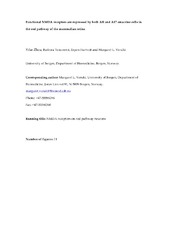| dc.contributor.author | Zhou, Yifan | en_US |
| dc.contributor.author | Tencerova, Barbora | en_US |
| dc.contributor.author | Hartveit, Espen | en_US |
| dc.contributor.author | Veruki, Margaret Lin | en_US |
| dc.date.accessioned | 2018-01-04T11:51:55Z | |
| dc.date.available | 2018-01-04T11:51:55Z | |
| dc.date.issued | 2016-01 | |
| dc.Published | Zhou Y, Tencerova B, Hartveit E, Veruki ML. Functional NMDA receptors are expressed by both AII and A17 amacrine cells in the rod pathway of the mammalian retina. Journal of Neurophysiology. 2016;115(1):389-403 | eng |
| dc.identifier.issn | 1522-1598 | |
| dc.identifier.issn | 0022-3077 | |
| dc.identifier.uri | https://hdl.handle.net/1956/17117 | |
| dc.description.abstract | At many glutamatergic synapses, non-N-methyl-d-aspartate (NMDA) and NMDA receptors are coexpressed postsynaptically. In the mammalian retina, glutamatergic rod bipolar cells are presynaptic to two rod amacrine cells (AII and A17) that constitute dyad postsynaptic partners opposite each presynaptic active zone. Whereas there is strong evidence for expression of non-NMDA receptors by both AII and A17 amacrines, the expression of NMDA receptors by the pre- and postsynaptic neurons in this microcircuit has not been resolved. In this study, using patch-clamp recording from visually identified cells in rat retinal slices, we investigated the expression and functional properties of NMDA receptors in these cells with a combination of pharmacological and biophysical methods. Pressure application of NMDA did not evoke a response in rod bipolar cells, but for both AII and A17 amacrines, NMDA evoked responses that were blocked by a competitive antagonist (CPP) applied extracellularly and an open channel blocker (MK-801) applied intracellularly. NMDA-evoked responses also displayed strong Mg2+-dependent voltage block and were independent of gap junction coupling. With low-frequency application (60-s intervals), NMDA-evoked responses remained stable for up to 50 min, but with higher-frequency stimulation (10- to 20-s intervals), NMDA responses were strongly and reversibly suppressed. We observed strong potentiation when NMDA was applied in nominally Ca2+-free extracellular solution, potentially reflecting Ca2+-dependent NMDA receptor inactivation. These results indicate that expression of functional (i.e., conductance-increasing) NMDA receptors is common to both AII and A17 amacrine cells and suggest that these receptors could play an important role for synaptic signaling, integration, or plasticity in the rod pathway. | en_US |
| dc.language.iso | eng | eng |
| dc.publisher | American Physiological Society | eng |
| dc.subject | amacrine cells | eng |
| dc.subject | Rod pathway | eng |
| dc.subject | NMDA receptors | eng |
| dc.subject | retina | eng |
| dc.title | Functional NMDA receptors are expressed by both AII and A17 amacrine cells in the rod pathway of the mammalian retina | en_US |
| dc.type | Journal article | |
| dc.date.updated | 2017-10-17T15:15:52Z | |
| dc.description.version | submittedVersion | en_US |
| dc.rights.holder | Copyright the Author(s) | |
| dc.identifier.doi | https://doi.org/10.1152/jn.00947.2015 | |
| dc.identifier.cristin | 1287531 | |
| dc.source.journal | Journal of Neurophysiology | |
| dc.relation.project | Norges forskningsråd: 214216 | |
| dc.relation.project | Norges forskningsråd: 213776 | |
